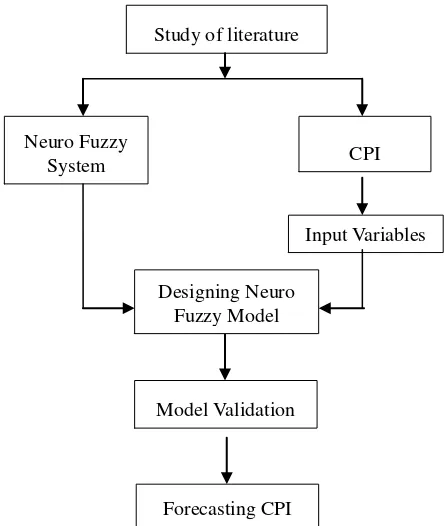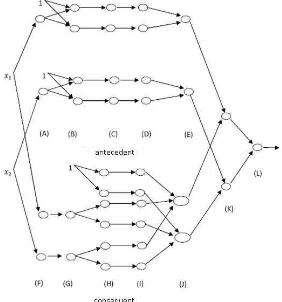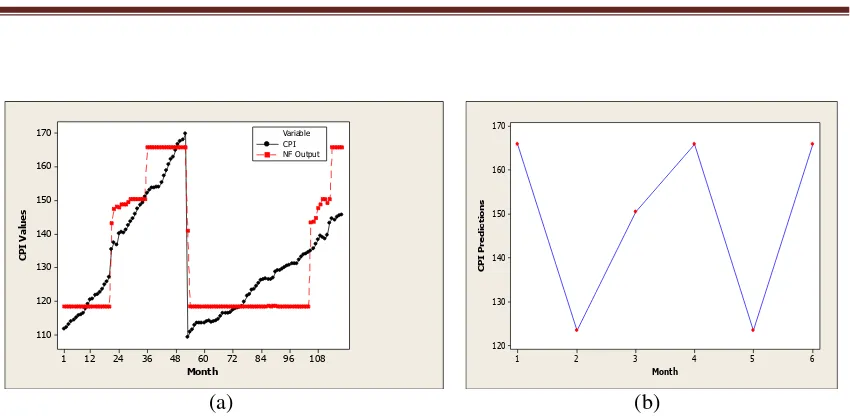M-145
APPLICATION OF NEURO FUZZY MODEL FOR FORECASTING
CONSUMER PRICE INDEX IN YOGYAKARTA
Agus Maman Abadi
Department of Mathematics Education, Faculty of Mathematics and Sciences, Yogyakarta State University, Indonesia
Abstract
The aim of this research is to predict the consumer price index (CPI) in Yogyakarta using neuro fuzzy model. The rule bases of neuro fuzzy model is constructed by tipe III, i.e. the consequent of fuzzy rules is linear combination of input variables. We apply the proposed method to predict CPI in Yogyakarta and the MAPE values of the model for training and testing data are 4.23% and 9.59%, respectively.
Key words: neuro fuzzy model, forecasting, consumer price index (CPI)
INTRODUCTION
Consumer Price Index (CPI) is an index that measures the average price changes between the time of a package of goods and services consumed by the population or households in urban areas with the basis of a certain period (http://www.bps.go.id). The Consumer Price Index is a number which shows a comparison between the relative price level (consumer or retail) at the time of the survey month and the price of the previous month (Badan Pusat Statistik, 2013). CPI is also an indicator used by the government to measure inflation in Indonesia.
Cutler, J. et al (2005) researched the empirical relationship between changes in commodity prices and CPI inflation in Hong Kong and Mainland China using a vector autoregression (VAR) analysis. Minarnik (2006) applied intervention method to overcome outliers to analyze time series of the CPI in Indonesia. Hertriesa, A. (2009) examined the Consumer Price Index for foodstuff and health in Jember using time series analysis. Boyacioglu,M.A. and Avci, D. (2010) applied an adaptive network-based fuzzy inference system (ANFIS) for the prediction of stock market return in the case of the Istanbul Stock Exchange. Then, Andriani, R. (2011) have modeled CPI of the food group using intervention and regression spline methods. Tripena, A. (2011) forecasted CPI and inflation in Indonesia with the Box-Jenkins ARIMA method. Listyowati (2011) researched the modeling of the CPI of transportation group based on consumption of fuel oil in Surabaya. Vector Autoregressive Model (VAR) has been used to analyze the effect of oil prices on the CPI (Hadiyatullah, 2011). Chen, T. (2011) evaluated the usefulness of the Bank of Canada Commodity Price Index for a leading indicator of inflation in Canada using bivariate vector autoregressive (VAR) model. Arini, P.S. and
Bendesa, IKG
(2012) applied ARIMA method to analyze the influence of Galungan Day on Seasonal Adjustment of CPI and to determine the primary commodities that affect inflation in the province of Bali. Azadeh, A. et al (2012) used a neuro-fuzzy approach to improve the natural gas price forecasting in vague and noisy environments. Hemanth, K.P., et al(2012) predicted stock trends using neuro fuzzy model. Forecasting CPI in Malang using the ARIMA method was done by Rosy,M. (2013). Maryam Ahmadifard et al (2013) predicted stock market return using ANFIS in the case of Tehran Stock Exchange. Kumar, J.K et al (2013) analyzed decision tool for stock market by hybrid network of neuro-fuzzy. Jha, G.K., and Sinha, K. (2013) forecasted agricultural price using artificial neural network (ANN) model. In this paper, the prediction of CPI in Yogyakarta using neuro fuzzy model will be established.
RESEARCH METHOD
The type of data used are secondary data, those are the data of consumer price index in Yogyakarta from January 2004 to December 2013 downloaded from http // www.bps.go.id. The prediction of CPI are done by the following steps.
Step 1. Perform pre-processing data to determine the significant input variables.
Step 2. Determine antecedent part of candidate fuzzy rules based on training data using fuzzy clustering.
Step 3.Determine consequent parameters of each fuzzy rule using least square error (LSE) method.
Step 4. Optimize the parameters of the fuzzy sets in each antecedent by using backpropagation network based on gradient descent method.
Step 5. Determine the neuro fuzzy model
output.
Figure 1 shows the flowchart to modeling CPI
Figure 1. The flowchart of CPI prediction Forecasting CPI
Model Validation Study of literature
CPI
Designing Neuro Fuzzy Model Neuro Fuzzy
System
M-147 RESULT AND DISCUSSION
Fuzzy system is a system combining fuzzifier, fuzzy rules, fuzzy inference, and defuzzifier. Neuro fuzzy system is a fuzzy system that optimization of parameters using neural network. In this system, parameters in antecedent and consequent of fuzzy rules are determined by neural network learning with backpropagation algorithm. In this paper, we use type III of fuzzy rule in the following form (Lin & Lee, 1996).
where:
i
R
is ith fuzzy rulek
x
is
k
thinput.
ij
A
is a fuzzy set in ith fuzzy rule and in jth input.ij
c
is a constant to be determinedFigure 2 shows the architecture of neuro fuzzy system with fuzzy rule bases type III.
Figure 2. Neuro Fuzzy Model with fuzzy rule bases type III (Lin & Lee, 1996)
1 1 2 2 from January 2004 to December 2013. The first 90 data are used to training and the rest data are used to testing. In the first step, to choose the significant input variables, we identify the plots of ACF and PACF of the data. From this step, lag1, lag2, lag3, lag4, lag5, lag6, and lag7 are candidates as input variables. Plots of ACF and PACF of CPI data are shown in Figure3.
(with 5% significance limits for the autocorrelations)
30
(with 5% significance limits for the partial autocorrelations)
Figure 3. Plots of ACF and PACF of CPI data
Then, selection of input variables is done by eliminating input variables that are not significant. Based on the maximum epoch = 1000, learning rate = 1, error tolerance = 10-6, and the minimum MSE value, the number of optimal neuron are 25, and the significant input is lag1, so we will construct neuro fuzzy model with 25 neurons in the hidden layers with input x(t-1) and output . Then, clustering process is applied to get the number of rules. We have three rules. For each rule, parameters in antecedent are determined by backpropagation learning process where fuzzy sets are represented by sigmoid bipolar membership function. Least square error (LSE) method is applied to get parameters in the consequent of each rule. Then, the parameters of the fuzzy sets in each antecedent are optimized by using backpropagation network based on gradient descent method.
Figure 4. (a). Plots of real CPI values and CPI prediction, (b). Plot of CPI prediction for the next six months
CONCLUSION AND SUGGESTION
In this paper, the procedure to construct neuro fuzzy model was established. The procedure was applied to predict the consumer price index (CPI) in Yogyakarta. The result was that the prediction of CPI in Yogyakarta gave good accuracy where the MAPE values of the model for training and testing data were 4.23% and 9.59%, respectively. The effect of seasonal is not considered in this model. In the next research, to improve the accuracy of model, we would like to apply the seasonal effect to modeling neuro fuzzy of CPI.
REFERENCES
Ahmadifard, M., Sadenejad, F., Mohammadi, I., and Aramesh, K.. 2013. Forecasting Stock Market Return Using ANFIS: The Case of Tehran Stock Exchange. International Journal of Advanced Studies in Humanities and Social Science, Vol.1, Issue 5, pp 452-459.
Andriani, R. 2011. Pemodelan Indeks Harga Konsumen Kelompok Bahan Makanan menggunakan Metode Intervensi dan Regresi Spline. Skripsi. Institut Teknologi Sepuluh Nopember Surabaya.
Arini, P.S., and Bendesa, IKG. 2012. Pengaruh Hari Raya Galungan Pada Seasonal Adjustment IHK dan Penentuan Komoditas Utama yang Mempengaruhi Inflasi di Provinsi Bali: Analisis ARIMA. Jurnal Ekonomi Kuantitatif Terapan. Vol. 5 No.2.
Azadeh, A., Sheikhalishahi, M., and Shahmiri, S.. 2012. A Hybrid Neuro-Fuzzy Approach for Improvement of Natural Gas Price Forecasting in Vague and Noisy Environments: Domestic and Industrial Sectors. International Conference on Trends in Industrial and Mechanical Engineering (ICTIME'2012) March 24-25, 2012, Dubai.
Boyacioglu,M.A. and Avci, D..2010. An Adaptive Network-Based Fuzzy Inference System (ANFIS) for the Prediction of Stock Market Return: The Case of the Istanbul Stock Exchange. Expert Systems with Applications, Vol. 37, pp 7908–7912.
Chen, T.. 2011. Does Commodity Price Index Predict Canadian Inflation?. Web Journal of Chinese Management Review, Vol. 14, No 1, pp 1-12.
Cutler, J., Carrie Chan, C., and Li, U.. 2005. The Relationship Between Commodity and Consumer, Prices in Mainland China And Hong Kong. Hong Kong Monetary Authority Quarterly Bulletin, pp 16-31.
Hadiyatullah. 2011. Model Vector Autoregressive (Var) dan Penerapannyauntuk Analisis Pengaruh Harga Migas terhadap Indeks Harga Konsumen (IHK). Skripsi. Universitas Negeri Yogyakarta.
Hemanth, K.P., Prashanth, K. B., Nirmala, T. V., and Basavaraj patil, S.. 2012. Neuro Fuzzy Based Techniques for Predicting Stock Trends. IJCSI International Journal of Computer Science Issues, Vol. 9, Issue 4, No 3, pp 385-391.
Hertriesa, A.. 2009. Penerapan Analisis Time Series terhadap Indeks Harga Konsumen di Kabupaten Jember. Skripsi. Institut Teknologi Sepuluh Nopember Surabaya.
Jha, G.K., and Sinha, K.. 2013. Agricultural Price Forecasting Using Neural Network Model: An Innovative Information Delivery System. Agricultural Economics Research Review, Vol. 26, No.2, pp 229-239.
Kumar, J.K., Ravi, G., and Mugilan, T.. 2013. Hybrid Network of Neuro-Fuzzy Based Decision Tool for Stock Market Analysis. International Journal of Computer Applications (0975 -8887) Vol. 70, No.17, pp 29-33.
Lin, C.T., and Lee, G. 1996. Neuro Fuzzy Systems. New Jersey: Prentice-Hall.
Listyowati. 2011. Pemodelan Indeks Harga Konsumen (IHK) Transportasi Berdasarkan Konsumsi Bahan Bakar Minyak (BBM) untuk Wilayah Surabaya. Skripsi. Institut Teknologi Sepuluh Nopember Surabaya.
Minarnik. 2006. Analisis Time Series terhadap Indeks Harga Konsumen (IHK) di Indonesia dengan Menggunakan Metode Intervensi untuk Mengatasi Outlier. Thesis. Institut Teknologi Sepuluh Nopember Surabaya
Rosy, M. 2013. Peramalan Indeks Harga Konsumen (IHK) Kota Malang Bulan Januari sampai Bulan Juni Tahun 2013 Menggunakan Metode Autoregressive Integrated Moving Average (ARIMA). Skripsi. Universitas Negeri Malang.
Tripena, A..2011. Peramalan Indeks Harga Konsumen dan Inflasi Indonesia dengan Metode ARIMA Box-Jenkins. Magistra.



